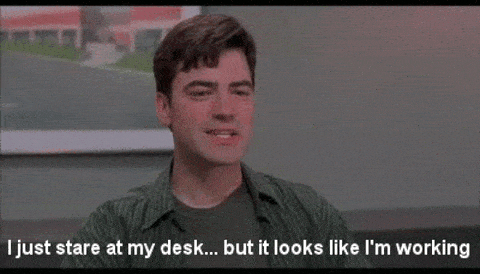Did your team do a good job today? How do you know?
Those questions are at the heart of how you measure employee productivity.
Most leaders are unable to pinpoint exactly why they think their team did a good or bad job. Was it because they showed up? Or because they worked hard? Or because you managed not to get in any fights? Or you all cleared out your email?
As we enter the digital age, it’s time to rethink the metrics we use to measure employee productivity.
Three horrible ways to measure employee productivity
Did you show up?
In the Industrial Revolution, employee productivity was easy to calculate because it was the same as that of a machine. It was output (measured down to the unit) divided by time (measured down to the minute).
Since the output from one human to another didn’t vary significantly, time was the most important element. The factory bought productivity in small units of time from workers.
When we shifted from factory work to office work, the nature of output changed. Instead of widgets, we were producing TPS reports. Or tax forms. Or customer calls. Or newsletters. But whatever the output was, we kept paying people based on time.
A reliance on time led us to the worst possible form of measuring productivity: presenteeism. If you showed up, you were productive. If you weren’t at the office, you weren’t working. As ridiculous as it sounds, the “butts in seats index” continues to be very prevalent.

Do you seem busy?
You can’t just show up, not do any work and expect to get paid, right? Of course not. You’ve got to be busy. You’ve got to hustle. You’ve got to generate buzz.
Some managers gauge employee productivity by their level of activity. This is also known as “working hard”.
In the office, you demonstrate activity by:
- Making sure people see you
- Having lots of open conversations
- Calling meetings
- Constantly typing on your computer
- Having a semi-messy desk
- Hanging out around the boss’ office
- Being ready to be pulled into meetings
But when activity is the metric for productivity, you often just run in circles. Nothing actually gets done. Worse, being ‘active’ distracts other people and prevents real work from getting done.
Did you clear out your communication?
In pre-digital times, handling your daily mail probably took somewhere between 5-30 minutes. Today, it might be the only thing you get done.
Using “no more communication” as a signal for employee productivity wasn’t common until email came to reign as the first king of the digital workplace. The amount of messages skyrocketed. Suddenly, getting to Inbox Zero was a laudable goal. In fact, it could be your only goal.

Using Inbox (or Slack) Zero as a metric for employee productivity is just as bad as the other metrics. It rarely results in progress and promotes a reactive type of work. People wait until someone else tells them to do something before starting something.
Inbox Zero is a useful proxy for roles like customer service, but for the rest of the workforce, it’s way overvalued.
Bad productivity metrics in a digital workplace
How do these horrible employee productivity metrics change when work converts to digital?
Presenteeism converts to installing activity monitoring software on everyone’s computer to verify they are actually logged in and working. Or, bosses pinging you at random times during the day to check and make sure you aren’t walking your dog.
Activity converts to praising employees who give blazingly fast replies on chat, send a lot of messages to others, and schedule a lot of video calls.
Inbox Zero is already a natively digital problem. As soon as you clear out all your messages, the vicious cycle starts over again.
Let’s look at it from another perspective. If you use any of these metrics, here’s the inbuilt bias you have about productive employees and slackers.
Productive employees
Slackers
Willing to burn themselves out for any reason
Avoid doing work that isn’t helpful to the goal
Watch the clock
Work when they can focus best
Distract others with constant communication
Reach out to others when required
Call lots of needless meetings
Avoid meetings unless necessary
Constantly stay in front of the boss
Leave the boss alone
See the problem? If you use the wrong metrics, good behaviors (those on the right) seem like they are detrimental to the team.
If you don’t get your metrics right, a team member can pretend like they are working all day and never actually get anything done. Or worse, they will believe they are helping the team, but not make any progress. Answering a Slack message from your boss becomes more important than finishing that strategy document.
Kick the activity habit
So, what is a better way to measure employee productivity as a digital leader?
Uncouple productivity and time worked. Time is a factor in being productive, but it can never be the sole metric, and usually isn’t as important as you think.
Get aligned. Most teams are not clear on their actual goals. If they have goals, they are vague, ill-defined, and without much meaning.
Nick Smarrelli, CEO of GadellNet, says, “Ambiguity provides stress and stress is a limiter for work. But clarity creates confidence.”
Adopt a framework like OKRs to help you clearly communicate what your team is doing.
Reject metrics that don’t matter. Does it matter to you how many hours your team puts in? Why?
Do you want them to be immediately responsive to messages throughout the day or on weekends? Why?
Would you rather they cleared out their inbox or closed more deals? Do you want to know they were working at 4:30pm on a Friday, or ship an important feature?
Nick says productivity needs to be linked to success, not to tasks.
“If you’ve defined what success looks like, then it doesn’t matter where you work or what hours you put in.”
Trust people. Once you set your objectives and are clear on how you are going to measure them, you’ve got to let go. Trust that people will do their work. Much of the bad productivity metrics come from a mistrust of team members to do their work.
Hold them accountable. Trust works both ways. If you give people space to get their work done and stop micromanaging, you should expect progress towards goals. If people are not meeting the metrics, revisit them, change your systems, have the productivity discussion, or find a new person for the role.
Why this won’t work for you
1. It’s harder.
It’s easy for leaders to hide behind activity. It’s easy to install software to prove people are at their desks. It’s easy to generate a lot of buzz. It’s easy to become indignant when challenged by others and show that you’ve “been working so hard”. It’s easy to show that you work late hours and send lots of emails.
Building clarity on your team objectives is harder. It takes months, and requires a lot of thinking and planning. It’s the path of most-resistance.
2. You can’t give up your old habits.
You might agree with everything in this article, but you’ll go right back to your old ways. You’ll get annoyed that people aren’t available when you want them to be. You’ll ask people to prove they’ve been working. You’ll not completely trust that they are doing what they say. You’ll call someone lazy who finishes all their work and checks out early.
In the end, it’s the team leader that chooses what metrics she’ll use to measure if her team did a good job. Most leaders don’t make a conscious choice, but reveal it through their actions and expectations. When it comes time for performance reviews, do you reward people who actually made progress in clearly defined goals, or those who generated activity?
Team members will quickly adapt to the leader’s expectations. If they figure out all they need to do is show up every day, they will do that. If they figure out they need to generate a lot of activity, they will do it.
You already have a metric you are using to measure employee productivity. Make sure it’s the right one.
Photo by Alex Kotliarskyi on Unsplash
Did your team do a good job today? How do you know?
Those questions are at the heart of how you measure employee productivity.
Most leaders are unable to pinpoint exactly why they think their team did a good or bad job. Was it because they showed up? Or because they worked hard? Or because you managed not to get in any fights? Or you all cleared out your email?
As we enter the digital age, it’s time to rethink the metrics we use to measure employee productivity.
Three horrible ways to measure employee productivity
Did you show up?
In the Industrial Revolution, employee productivity was easy to calculate because it was the same as that of a machine. It was output (measured down to the unit) divided by time (measured down to the minute).
Since the output from one human to another didn’t vary significantly, time was the most important element. The factory bought productivity in small units of time from workers.
When we shifted from factory work to office work, the nature of output changed. Instead of widgets, we were producing TPS reports. Or tax forms. Or customer calls. Or newsletters. But whatever the output was, we kept paying people based on time.
A reliance on time led us to the worst possible form of measuring productivity: presenteeism. If you showed up, you were productive. If you weren’t at the office, you weren’t working. As ridiculous as it sounds, the “butts in seats index” continues to be very prevalent.

Do you seem busy?
You can’t just show up, not do any work and expect to get paid, right? Of course not. You’ve got to be busy. You’ve got to hustle. You’ve got to generate buzz.
Some managers gauge employee productivity by their level of activity. This is also known as “working hard”.
In the office, you demonstrate activity by:
- Making sure people see you
- Having lots of open conversations
- Calling meetings
- Constantly typing on your computer
- Having a semi-messy desk
- Hanging out around the boss’ office
- Being ready to be pulled into meetings
But when activity is the metric for productivity, you often just run in circles. Nothing actually gets done. Worse, being ‘active’ distracts other people and prevents real work from getting done.
Did you clear out your communication?
In pre-digital times, handling your daily mail probably took somewhere between 5-30 minutes. Today, it might be the only thing you get done.
Using “no more communication” as a signal for employee productivity wasn’t common until email came to reign as the first king of the digital workplace. The amount of messages skyrocketed. Suddenly, getting to Inbox Zero was a laudable goal. In fact, it could be your only goal.

Using Inbox (or Slack) Zero as a metric for employee productivity is just as bad as the other metrics. It rarely results in progress and promotes a reactive type of work. People wait until someone else tells them to do something before starting something.
Inbox Zero is a useful proxy for roles like customer service, but for the rest of the workforce, it’s way overvalued.
Bad productivity metrics in a digital workplace
How do these horrible employee productivity metrics change when work converts to digital?
Presenteeism converts to installing activity monitoring software on everyone’s computer to verify they are actually logged in and working. Or, bosses pinging you at random times during the day to check and make sure you aren’t walking your dog.
Activity converts to praising employees who give blazingly fast replies on chat, send a lot of messages to others, and schedule a lot of video calls.
Inbox Zero is already a natively digital problem. As soon as you clear out all your messages, the vicious cycle starts over again.
Let’s look at it from another perspective. If you use any of these metrics, here’s the inbuilt bias you have about productive employees and slackers.
| Productive employees | Slackers |
|---|---|
| Willing to burn themselves out for any reason | Avoid doing work that isn’t helpful to the goal |
| Watch the clock | Work when they can focus best |
| Distract others with constant communication | Reach out to others when required |
| Call lots of needless meetings | Avoid meetings unless necessary |
| Constantly stay in front of the boss | Leave the boss alone |
See the problem? If you use the wrong metrics, good behaviors (those on the right) seem like they are detrimental to the team.
If you don’t get your metrics right, a team member can pretend like they are working all day and never actually get anything done. Or worse, they will believe they are helping the team, but not make any progress. Answering a Slack message from your boss becomes more important than finishing that strategy document.
Kick the activity habit
So, what is a better way to measure employee productivity as a digital leader?
Uncouple productivity and time worked. Time is a factor in being productive, but it can never be the sole metric, and usually isn’t as important as you think.
Get aligned. Most teams are not clear on their actual goals. If they have goals, they are vague, ill-defined, and without much meaning.
Nick Smarrelli, CEO of GadellNet, says, “Ambiguity provides stress and stress is a limiter for work. But clarity creates confidence.”
Adopt a framework like OKRs to help you clearly communicate what your team is doing.
Reject metrics that don’t matter. Does it matter to you how many hours your team puts in? Why?
Do you want them to be immediately responsive to messages throughout the day or on weekends? Why?
Would you rather they cleared out their inbox or closed more deals? Do you want to know they were working at 4:30pm on a Friday, or ship an important feature?
Nick says productivity needs to be linked to success, not to tasks.
“If you’ve defined what success looks like, then it doesn’t matter where you work or what hours you put in.”
Trust people. Once you set your objectives and are clear on how you are going to measure them, you’ve got to let go. Trust that people will do their work. Much of the bad productivity metrics come from a mistrust of team members to do their work.
Hold them accountable. Trust works both ways. If you give people space to get their work done and stop micromanaging, you should expect progress towards goals. If people are not meeting the metrics, revisit them, change your systems, have the productivity discussion, or find a new person for the role.
Why this won’t work for you
1. It’s harder.
It’s easy for leaders to hide behind activity. It’s easy to install software to prove people are at their desks. It’s easy to generate a lot of buzz. It’s easy to become indignant when challenged by others and show that you’ve “been working so hard”. It’s easy to show that you work late hours and send lots of emails.
Building clarity on your team objectives is harder. It takes months, and requires a lot of thinking and planning. It’s the path of most-resistance.
2. You can’t give up your old habits.
You might agree with everything in this article, but you’ll go right back to your old ways. You’ll get annoyed that people aren’t available when you want them to be. You’ll ask people to prove they’ve been working. You’ll not completely trust that they are doing what they say. You’ll call someone lazy who finishes all their work and checks out early.
In the end, it’s the team leader that chooses what metrics she’ll use to measure if her team did a good job. Most leaders don’t make a conscious choice, but reveal it through their actions and expectations. When it comes time for performance reviews, do you reward people who actually made progress in clearly defined goals, or those who generated activity?
Team members will quickly adapt to the leader’s expectations. If they figure out all they need to do is show up every day, they will do that. If they figure out they need to generate a lot of activity, they will do it.
You already have a metric you are using to measure employee productivity. Make sure it’s the right one.
Photo by Alex Kotliarskyi on Unsplash
)
)
)







